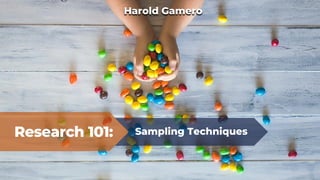
Research 101: Sampling Techniques in Research
- 1. Research 101: Sampling Techniques Harold Gamero
- 2. Sampling Definition Process by which a subgroup of a population is selected to make observations of a population to make observations and statistical and statistical inferences. • Collecting information from an entire population is virtually impossible • Sample must be truly representative of the population of interest (universe of units of analysis) • Inadequate or biased samples are the main cause of erroneous inferences. • Can be selected through randomized procedures (probabilistic sampling) or non-random criteria procedures (non-probability sampling).
- 3. •Group to which the results are to be generalized. •These are all the units of analysis that exist. •It is the part of the population that is accessible and identifiable. •Usually in a contact list. •Unit of analysis vs. sampling unit. •Fragment of the population that is analyzed by the researcher. •It can be of two types: probabilistic or non-probabilistic. Sampling process Population Sampling frame Sample
- 4. Non-probability sampling • Technique in which some units of the population have zero chance of selection or where the probability of selection cannot be accurately determined. • Selection based on certain non-random criteria. • Does not allow the estimation of sampling errors • Information from a sample cannot be generalized back to the population. • Types of nonprobability sampling techniques include convenience sampling, quota sampling, expert sampling, snowball sampling. • Best fit for qualitative researches.
- 5. Non-probability sampling Elements of the sample are chosen because they are close to hand, readily available, or convenient. Convenience sampling Quota sampling Expert sampling Snowball sampling Any non-random sampling, where the set is segmented into mutually exclusive subgroups, representing the population stratification. Respondents chosen based on their expertise on the phenomenon being studied. Identification of a few respondents that match the criteria, and then ask them to recommend others they know who also meet the criteria. For example: If you stand outside a shopping center and hand out questionnaires or interview them as they walk in or out. Proportional QS Proportion of sample matches the population stratus. Non-proportional QS Not respecting proportions. Useful when: Credible opinions about a complex topic are needed. Only way to study hard-to-reach populations or when no sampling frame is available.
- 6. Probability sampling • Technique in which every unit in the population has a chance (non-zero probability) of being selected (statistically). • This chance can be accurately determined, making the sample good for statistical analysis and inferences. • The different types of probability sampling techniques include Simple random sampling, systematic sampling, stratified sampling, cluster sampling, matched-pairs sampling, and multi-stage sampling. • Best fit for quantitative researches.
- 7. Probability sampling Definition Sampling technique in which all the units of the population have the same probability of the population have the same probability of being chosen. • All probability samples have two characteristics in common: a) All units have probabilities of being chosen (never zero). b) The selection process is somewhat random.
- 8. Probability sampling •It consists of the random selection of elements of the sampling frame. Simple •The sampling frame is ordered according to some criterion. •The first element is chosen randomly and the following ones under the ratio K=N/n. Systematic •The sampling frame is divided into mutually exclusive subgroups. •Simple random sampling is then applied to each subgroup. Stratified
- 9. Probability sampling •When the population is widely dispersed geographically. •The population is divided into clusters and then all the units in these clusters are studied. By clusters •When it is desired to compare two subgroups of the population under some criterion. Matched-pairs •Sampling involving two or more types of sampling at different stages. Multi-stage
- 10. Sampling statistics Variable (Age) Frequency (Students) 18 19 20 21 22 23 24 25 26 27 28
- 11. Sampling statistics Variable (Age) 1 answer Frequency (Students) 18 19 20 21 22 23 24 25 26 27 28
- 12. Sampling statistics Variable (Age) 43 responses Frequency (Students) 18 19 20 21 22 23 24 25 26 27 28
- 13. Sampling statistics Frequency (Students) 249 responses (Sample) Variable (Age) 18 19 20 21 22 23 24 25 26 27 28
- 14. Sampling statistics Variable (Age) Frequency (Students) 249 responses (Sample) 18 19 20 21 22 23 24 25 26 27 28
- 15. Sampling statistics Variable (Age) Frequency (Students) Normal distribution 18 19 20 21 22 23 24 25 26 27 28
- 16. Sampling statistics Positive asymmetry Negative asymmetry
- 18. Sampling statistics Population Sample 1 Sample 2 Sample 3 _ X=21 _ X=23 _ X=25 _ X=23 __ Xs Normal Distribution of Samples . . .
- 19. Sampling statistics Population (Parameters) Sample (Statistics) Average age = 23 years old Average age = 25 years old Standard Error
- 20. Sampling statistics Sample (Statistics) Individual Response Average age = 25 years old Age = 21 years old Standard deviation
- 21. Sampling statistics Largest standard deviation Lower standard deviation
- 22. Sampling statistics • Standard deviation, variance and sum of squares mean the same thing: a) The fit of the mean to the sample data. b) Data variability. c) How well the statisticians represent the sample data. d) The amount of error in statistical calculations.
- 23. Sampling statistics Confidence intervals Variable (Age) Frequency (Students) µ ± 3σ = 99%*. µ ± 2σ = 95%*. µ ± 1σ = 68%*. *Probability of the parameter being within the confidence interval of the statistic 18 19 20 21 22 23 24 25 26 27 28
